South Pacific
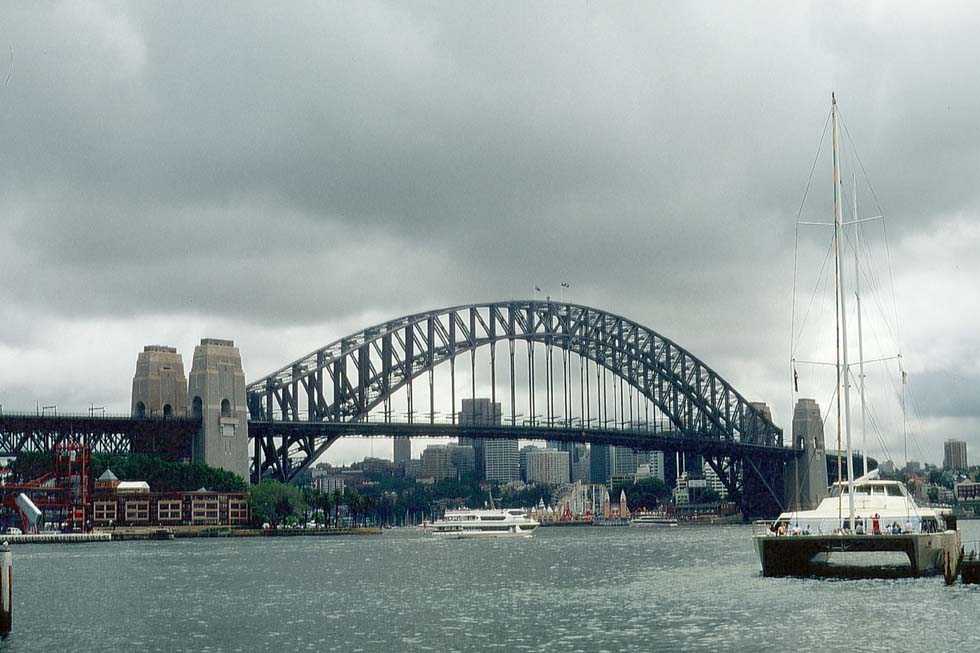
Sydney (WS)
This region comprises South East Asia, the world of Buddhism, Indonesia, the world of Muslim tradition, and the new world of Australia and New Zealand. And it is the region of Polynesia, of the Pacific islands, where seafaring has a deep-rooted tradition.
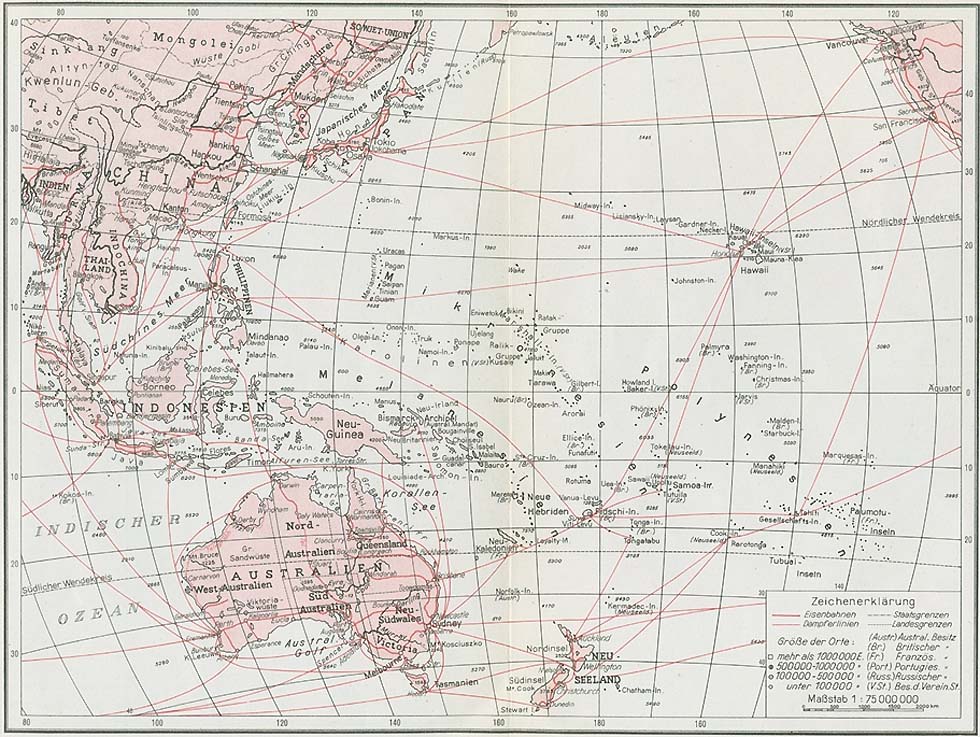
Map of 1949 with shipping lines
Australian Branch Lines
Among the various regional services, those branch lines which connected with the great mail routes were the most important ones. When the Australian Mail contract with the P&O had to be renewed in 1873, the state of Victoria and the Sydney council fought for providing the terminus. E.A. Ewart informed: "Victoria at last made an offer which, being the only one under the conditions, was therefore accepted (...) but Victoria's strict stipulation was that, under the new contract, the mail should be carried only as far as Melbourne (...) The natural result was that the mails and passengers carried to and from Melbourne had to be transshipped there into a branch-line steamer which the P&O put on to carry them between Melbourne and Sydney. This contract (...) ran on until a new one was made in 1880". The report didn't mention a possible reason for Victoria's obstinacy: A rail connection Melbourne - Sydney was pushed forward and from 1883 or 84 a non-passenger carrying train, known officially as K200, left for Sydney loaded with the English mailbags. The necessary change of trains at Albury possibly was the reason why the sea route remained victorious. At Melbourne, only the clippers had come up the Yarra River close to the city. The steamers called at Port Melbourne, the former Sandridge, from 1854 already connected by rail. In West Australia, the port-of-call initially was little Albany, for a coal depot had been erected there. Only from 1900 the steamers changed to the new artificial harbour of Fremantle. About the P&O route E.A. Ewart found out further details: "The first call of the "Chusan" at Adelaide was made on her way from Sydney and Melbourne on the 11th September, 1852 (...) Adelaide, however, was not continued as a calling port in the first contracts, and it was not until 1874 that South Australia secured what she claimed was a due recognition of her postal rights (...) They had to submit and make the best of a bad business by running their own Adelaide service between there and Albany to carry the mails".
About another initiative J.M. Maber reported in 'North Star to Southern Cross': "The Australasian Steam Navigation Co. had been founded in 1851, as the successor of the Hunter River Steam Navigation Co. with the intention of providing services to the outlying Pacific islands as well as around the coasts of Australia and New Zealand. (...) In later years the company's activities had been extended to New Caledonia and Fidji."
In 1875 the Adelaide Steamship Co. was founded and in 1882 they swallowed the Spencer's Gulf SS Co. Cook's timetable mentioned at the end of the 19th century their main lines Melbourne - Adelaide - West Australia and Melbourne - Sydney - Queensland ports. In 1935 the company brought out three magnificent 10,000-tonners. One of them, the "Manoora", had the honour of being the last of the Australian coastal liners, when services were closed down in 1961. Thomas K. Fitchett ("The Vanished Fleet") had described her fate as an Indonesian ship under several names, appearing even in the Red Sea on pilgrims services.
The Queensland Government chartered in 1865 the small steamer "Hero" from Bright Bros. and employed her in a new service between Brisbane and Batavia, connecting with the British India Line, thus pioneering the Torres Strait route. In 1881 the British India Line inaugurated a service London - Batavia - Brisbane with the 2,971-ton "Merkara" in cooperation with subsidiaries. In later years Cook's timetable listed it as a British India/Queensland Royal Mail Line route. In 1883 the British India had supported foundation of the Queensland SS Co., which three years later merged with the competing Australasian SN Co. and formed the Australasian United SN Co., known as AUSN. The old Australasian had been formed in 1851 with the intention of providing services to New Zealand and to Pacific islands. After AUSN introduced the "Indarra" (9,735 gt) in 1913 on coastal services, that steamer bearing the colours of the cooperating British India Line was praised as a sumptuous liner, but was soon despised for her rough ride. In 1919 the Orient Line used her on two voyages to England, but returned her to her owners. When passenger services ended in 1955, AUSN's last liner, the "Ormiston" (built in 1922 for the Khedivial Mail as "Famaka"), was sold to Greece. The Australasian was engaged also in coastal shipping. After the Queensland Railway along the East Coast reached Gladstone, their 'Gladstone Boat Mail' connected between 1898 and 1903 with an AUSN steamer service to Paramount and Townsville in the north.
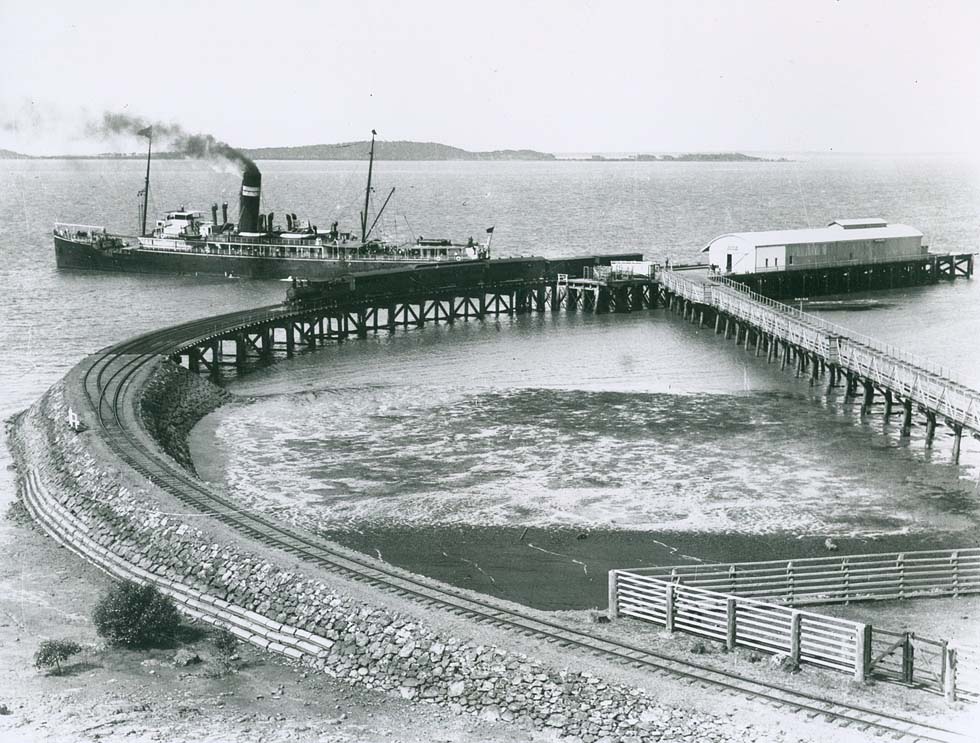
"Barcoo" of AUSN and the Gladstone Boat Mail at Gladstone Wharf between 1898 and 1903 (coll. Queensland Rys., via Ray Ellis)
There were other early operators of Tasman Sea services, too. Huddart Parker Ltd was a pioneer, engaged in coastal and New Zealand shipping, creating in 1921 the Tasmanian Steamers Pty Ltd in cooperation with the Union SS Co of New Zealand, which had bought the Tasmanian SN Co. already in 1891. Other providers of coastal services were the Howard Smith Ltd, the Melbourne SS Co., McIlwraith McEachern Ltd and the state-owned Western Australian Coastal Shipping Commission.
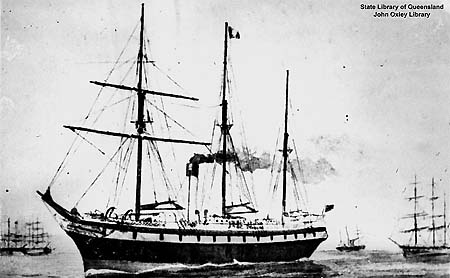 "Alhambra", ex P&O, introduced in 1862 on Tasman Sea services by McMeckan, Blackwood & Co. (State Library of Queensland, via Wikimedia)
"Alhambra", ex P&O, introduced in 1862 on Tasman Sea services by McMeckan, Blackwood & Co. (State Library of Queensland, via Wikimedia)
In 1873 Bright Bros. had initiated foundation of the Eastern & Australian Mail SS Co., starting an Australia - Singapore route. After 1881 they concentrated on China and Japan services. Later the company became associated with the AUSN and thus in 1919 became controlled by the British India Line and finally by the P&O. Fremantle was connected with Singapore from the 1880's by the West Australian S.N. Co. and Burns, Philp & Co. provided a Sydney - Singapore service. An Australian Line from Japan was advertised e.g. in the US Official Guide of 1916 by Nippon Yusen Kaisha.
During World War II, the Pacific War, Australia and New Zealand were not conquered. Even after P&O had changed to the cruise trade in 1973, other companies provided regular services Singapore - Australia. The former M.S. "Jean Laborde" (10,909 gt) of Messageries Maritime reappeared in 1974 as "Eastern Princess" of Helite (Hellenic Italian Lines) on a Singapore - Australia route, before she was sold in 1976 to Epirotiki for Mediterranean cruises as "Oceanos". The ABC at the end of the '70s listed the Blue Funnel Line with the "Centaur", CTC Lines agency with the "Turkmenia" Singapore - Fremantle and Shipjet with the "Kota Singapura" Singapore - Fremantle "including flight connection". People made a joke of Blue Funnel Line's "Centaur" (1964/ 8,262 gt), saying that "she carried some 4,700 passengers, of whom only 180 were human". Her main trade was the transport of cattle on a Fremantle - Singapore - Hong Kong - Manila route. In 1982 she was sold to South Africa. A surprising episode (described by 'Die grossen Passagierschiffe der Welt') was the charter of the "Arafura Lily" (1996/ 12,307gt, a passenger-cargo vessel, built as "Zi Ding Xiang" for Shanghai Hai Xing) by Southern Cross for a Brisbane - Singapore service.
New Zealand Branch Lines
"In the 1850s (...) nearly all mail would have been handled via Australia, with exception of that carried on sailing ships traveling to New Zealand", informed R.M. Startup of the Postal History Society of New Zealand. "In 1854 the Auckland Provincial council arranged for a scheduled steamer service to carry mails to and from Sydney, and early in 1857 the Wellington Province arranged for another steamer service between Wellington and Melbourne. J.M. Maber mentioned the 595-ton "William Denny" pioneering the monthly service Auckland - Sydney in 1854 under contract to the New Zealand Provincial Government. In 1858 the Intercolonial Royal Mail Steam Packet Co. commenced operations Auckland - Sydney, followed by a branch line to Lyttelton and Port Chalmers on the South Island. From the same year Maber reported the institution of a Melbourne - Wellington service by the Australasian Steam Navigation Co. R.M. Startup continued: "After abolition of provinces in 1876 the shipping service became more rationalized and the Union Steam Ship Co. developed". The red funnels of their steamers became a trademark on the Tasman Sea. About that company, E.A. Ewart informed that they had "...its origin in a few small steamers of 300 and 400 tons, running between Dunedin and Port Chalmers, and in the Harbour Steam Co. coordinating these services. This company was re-formed in 1875 under the present title (...). For the first two years the Union ran only local coastal services, but in 1877 two steamers were bought and put on the 'inter-colonial' run to Sydney. A year later (...) a new weekly service was opened between New Zealand and Melbourne. One year more, and other vessels were being built and bought, including the "Rotomahana" of 1,727 tons (...). She was known as 'The Greyhound of the Pacific'. (... In 1936) the Union had a magnificient luxury liner built by Vickers- Armstrong. The "Aweata" is of 14,000 tons, with a speed of 23 knots, and her arrival in New Zealand after a passage out of Panama in record time was hailed with acclamation, and after she went on the New Zealand - Australia run, she was speedily christened 'Queen of the Tasman'".
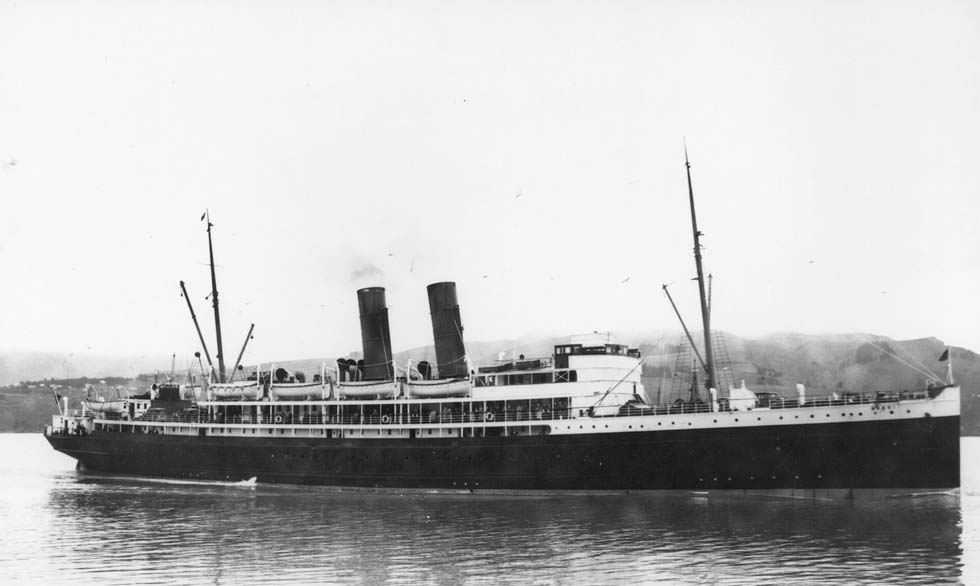
"Maori" of 1908, Union SS Co of New Zealand (official photo)
Also the traditional link between the Northern and the Southern Island of New Zealand was provided by the Union SS Co. with the shipping service from Wellington to Lyttelton, where special boat trains connected with important Christchurch. While the Cape gauge railway on the Northern Island between Wellington and Auckland had been opened in 1908, the railway line between Picton on the Southern Island and Lyttelton was completed not before 1944.
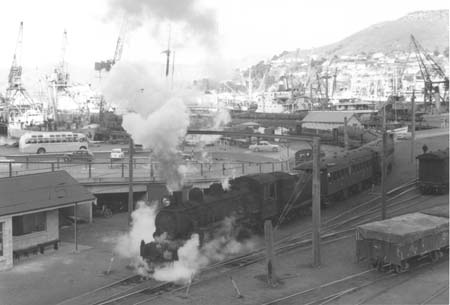 Lyttelton no3 wharf, ferry train with class Ab on departure, Oct.1965 (Hugh Bennett)
Lyttelton no3 wharf, ferry train with class Ab on departure, Oct.1965 (Hugh Bennett)
Philippine Branch Lines
The Philippine colony of Spain was served by the Spanish navy. After 1845, P&O steamers brought mail from Spain to Hong Kong, where it was reloaded to Spanish men-of-war. In 1857 the P&O entered a contract for a Spanish mail service Hong Kong - Manila, but on account of corruption the P&O suspended it after not even two years. Much later, in 1873, the Marques de Campo acquired the "Vinuelas" for Philippine services. In 1883 she became the "San Ignacio de Loyola" of the Compania Trasatlantica, which connected Spain with the Philippines. After the war of 1898 the islands became an American colony, from 1916 with some autonomy, and then a destination of trans-Pacific steamers.
Indonesian Branch Lines
What's now Indonesia, was in Dutch hands. A Dutch navy mail service Singapore - Batavia is reported (by Dr. Hogesteeger: Naar de Gordel van Smaragd) from 1845. The same source mentions also the little "De Prins van Oranje" of Cores de Vries, employed between Singapore and Batavia. Another source stated that a private steamer service between these ports, connecting with the P&O, was established in 1854. A mail contract was granted to the British India Line in 1866. The Nederlandsch-Indische Stoomboot Maatschappij was created with British capital. In 1888 the Koninklijke Paketvaart Maatschappij or KPM was founded in Java for services in this region. Their biggest ships were of moderate size - the "Celebes" (2,300 gt) of the late 1890's and the "Plancious" (5,600 gt) after WWI. The timetable towards the end of the 19th century listed 15 lines of that Royal Dutch SS Co. connecting with the SM Nederland and the Rotterdam Lloyd at Batavia. The routes reached as far as Singapore, Borneo, Celebes, Timor, New Guinea and to the southern coast, passing the Sunda Strait, where in 1883 the horrible eruption of the Krakatau volcano had occurred. At Singapore and Penang connection with other ocean liners was provided.
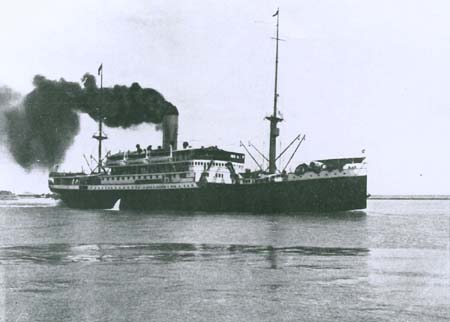 "Tasman"of KPM, leaving Tandjoeng Priok (publication 1923)
"Tasman"of KPM, leaving Tandjoeng Priok (publication 1923)
A matter of its own was the Koninklijke Java-China-Paketvaart Linjen N.V., which provided services between Yokohama, Singapore, Cape Town and Buenos Aires even decades after WWII (see also chapter China Sea). Messageries Maritimes of France operated a branch line Singapore - Batavia - Samarang already in the 19th century.
Pacific Island Branches
The big island of New Guinea was divided up in a Dutch part, a British, later Australian part Papua and from 1885 a German Kaiser-Wilhelms-Land, from 1919 Australian. Micronesian islands changed with WWI from German to Japanese administration. East Timor was a Portuguese colony.
The Nederlandsch-Indische Stoomboot Maatschappij connected Batavia with Sumatra, Borneo, Celebes, Timor, Amboina, New Guinea and the Bismarck-Archipelago. Mails for Deutsch-Neuguinea were conveyed initially by the British India Line to Cooktown, Queensland, and further on to Finschhafen by the tiny "Ottilie" of the Neu-Guinea-Compagnie, introduced in 1887, replaced in 1889 by a line from Surabaya. The "Ottilie" sank near the Purdy Islands and in 1891 the "Schwalbe" was chartered from NDL for a Singapore connection. In 1893 Norddeutscher Lloyd (NDL) started the "Neu-Guinea-Zweiglinie" from Singapore (replacing its Sydney -Samoa branch line) and extended it in 1900 to Sydney. A Hong Kong - Sydney line of the NDL was short-lived. In 1901 a service Sydney - Marshall Islands - Caroline Islands was introduced by the Jaluit-Gesellschaft, in 1902 extended to Hong Kong and from 1904 their "Germania" called at Saipan, Mariana Islands. Burns, Philp & Co. linked from 1904 also Deutsch-Neuguinea. NDL operated around the turn of the century also coastal lines from Singapore to North Borneo and to Bangkok, from Bangkok to Hong Kong and from there to Swatow. After WWI only a NDL branch line Hong Kong - New Guinea - South Pacific was opened in 1929. The Messageries Maritimes timetable showed e.g. in 1925 a connecting line from Sydney to Nouvelle Caledonie and the New Hebride Islands.
During World War II, Japan had conquered the South Pacific region, including Indonesia and many islands. After the defeat of the occupants, Indonesia achieved full independence in 1949. Papua New Guinea became an independent state in 1975, followed by various island states. Nouvelle Caledonie (New Caledonia) and French Polynesia decided for French rule.
Australian Ferries
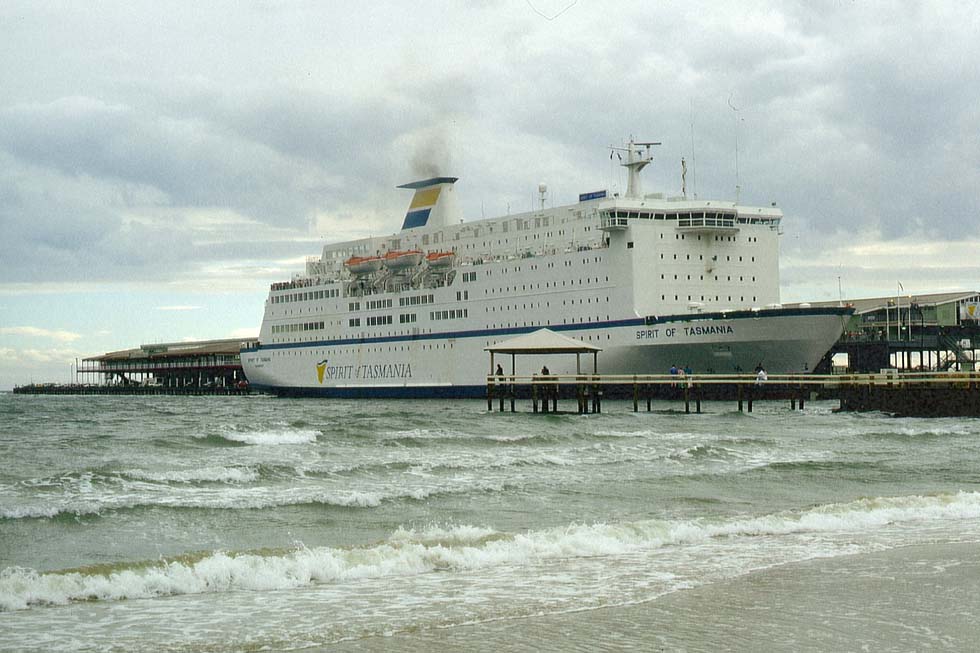
"Spirit of Tasmania" (ex "Peter Pan" of 1986), bound for Devonport, at Port Melbourne 1997 (WS)
What remained from all the wide-spread shipping services? ABC Shipping Guide showed at the end of the '70s no longer any ocean line to New Zealand. Even the Australia - New Zealand services have disappeared and then also the last Blue Funnel liner Australia - Singapore became withdrawn. The last classic steamer on the Tasman route, the "Taroona" of the Tasmanian Steamers Pty Ltd, was sold in 1959 to Typaldos of Greece, being renamed "Hellas". The cooperating Union S.S. Co. of New Zealand changed in 1964 to the first car ferry services with the "Seaway King" and "Seaway Queen".
The Australian Coastal Commission introduced in 1965 the passenger motor-ship "Empress of Australia" (12,037 gt) on a Sydney - Hobart - Bell Bay - Burnie service, later confined to an Australian National Line which offered a car ferry service Port Melbourne - Devonport, Tasmania, closed down in 1985. The Department of Transport continued services to Tasmania, acquiring the "Nils Holgersson" (19,212 gt) of the German company TT-Line, renamed "Abel Tasman". In 1993 that Australian partner TT-Line Pty. Ltd. became wholly owned by the Government of Tasmania. The first ship was replaced with the "Peter Pan" (1986/ 31,356 gt), registered as "Spirit of Tasmania". In the late 90s InCat catamaran operations were added. In 2002 the red/white "Superfast III" and IV (29,067 gt) were acquired as "Spirit of Tasmania II" and I. In 2003 the "Superfast II" was introduced as "Spirit of Tasmania III" on a Sydney - Devonport service. Needing subsidies, it was called into question by the government and the vessel was sold in 2006 to Corsica Ferries. After the first decade of the 21st century, services of the TT-Line were listed (via Wikipedia) with the "Spirit of Tasmania I" and II, the former "Superfast IV" and III.
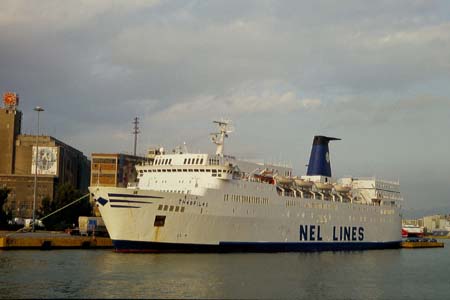
The former "Abel Tasman" (ex "Nils Holgersson) as "Theofilos" at Piraeus, 2007 (WS)
|
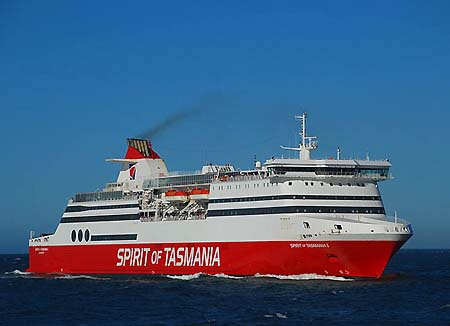
"Spirit of Tasmania I" (ex "Superfast IV"), in late 2007 (Synyan, via Wikimedia)
|
For tourists the island services and the Barrier Reef cruises of several companies and a harbour tour with Sydney Ferries are of special interest. Various local services continued, at Perth and Sydney also with catamarans.
New Zealand Ferries
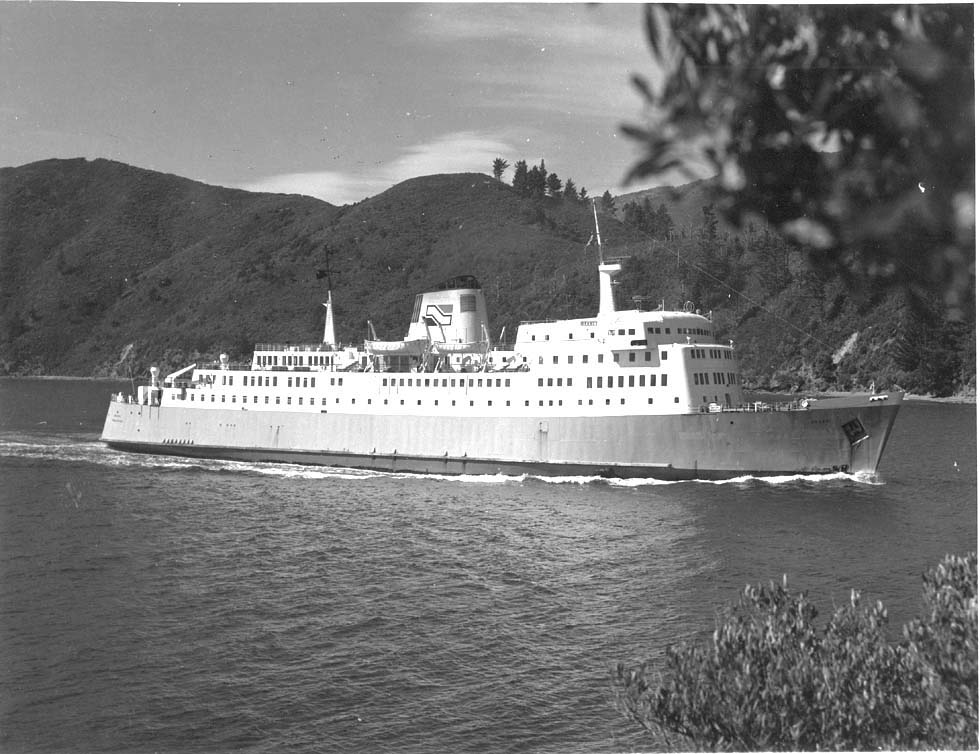
"Aranui" of New Zealand Railways, nearing Picton (NZR Publ. Photo)
The Union S.S.Co. of New Zealand, known as the Union Line, employed in the 1960s (according to C. Frick) the car ferry "Maori" (1953/ 8,303 gt) on the Wellington - Lyttelton service, but also other vessels were watched on this route. A special ferry wharf has been prepared at Lyttelton for roll-on roll-off services. The cargo-passenger motor-ships "Matua" (1936/ 4,250 gt) and "Tofua" (1951/ 5,299 gt) were listed for services to the Fiji Islands, Tonga and Samoa.
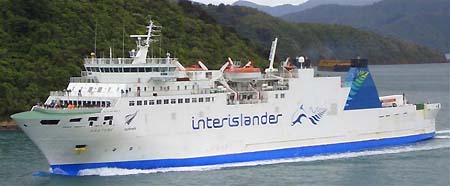
"Aratere" of Interislander, 2006 (Burll 662, via Wikimedia)
|
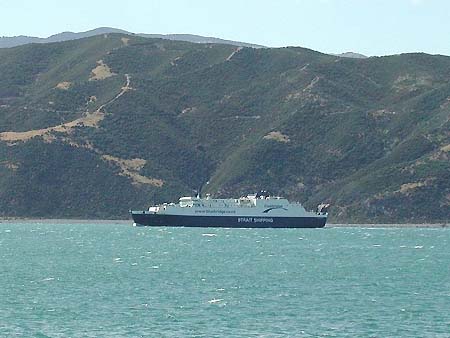
Bluebridge ferry nearing Wellington harbour, 2007 (Pseudopanax, via Wikimedia)
|
In New Zealand, private companies traditionally provided services Wellington - Picton, connecting the Northern and the Southern Island. In 1962 New Zealand Railways entered that business, first with the "Aramoana" (4,160 gt), followed by the "Aranui" and the refurbished "Aratika", rail ferries carrying also passengers, but no regular passenger trains. In 1991 the railways changed name to Tranz Rail. Now the Interisland Line, railway-owned, and Bluebridge, the successor of Strait Shipping, are maintaining ferry services on the route Wellington - Picton. Between 1995 and 1997 the Uruguayan company Buquebus offered a hi-speed service Wellington - Picton with the "Albayzin" of the Spanish Mestral 96 type. Then Tranz Rail has introduced the lnCat 046 catamaran "The Lynx". The old shipping route Wellington - Lyttelton however had disappeared for passengers long before. Of course there are various island routes. For the local traffic at Auckland, the Fullers Group started hi-speed services.
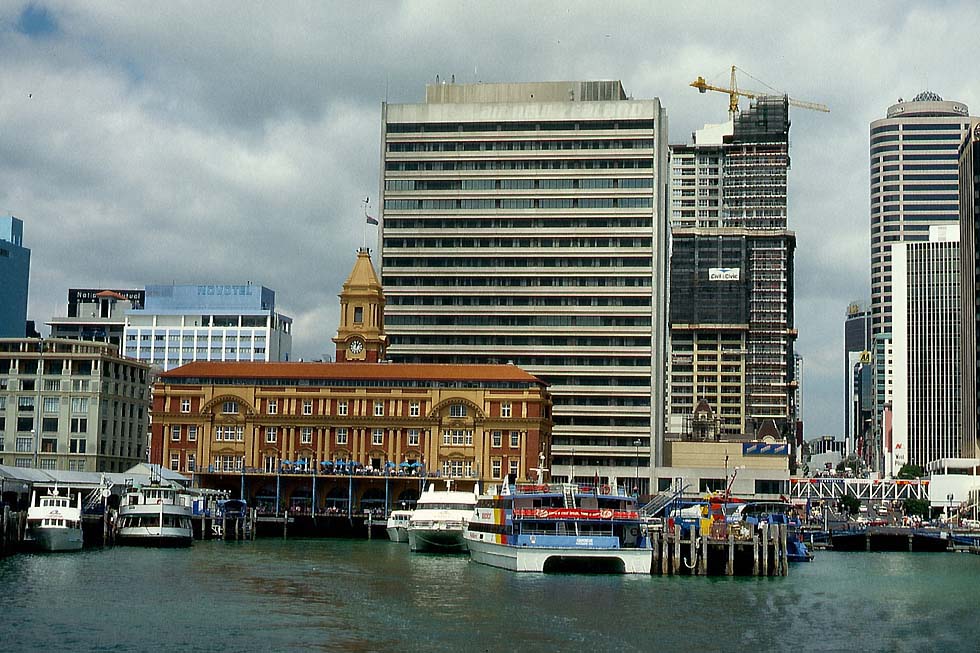
Auckland harbour, 1997 (WS)
Philippine Ferries
The Republic of the Philippines with a population of more than 70 million had been conquered by the Japanese in late 1941 and was liberated by the USA in 1944, achieving independence in 1946.The country was ruled until 1986 by dictator Marcos, harassed by poverty, emigration being a result. The state consists of c.850 inhabited islands and shipping services have a long tradition.
Before WWII the diesel-powered 3,200-ton "Don Isidro" of 1939 became known. Still at the end of the 1970s the ABC Shipping Guide listed conventional inter-island services by roughly a dozen companies, William Lines, Sweet Lines and Aboitiz Shipping Corp. representing the biggest. Newport Shipping, Marino, Cia. Maritima, Negros Navigation, Lorenzo Shipping, Carlos A. Gothong Lines, MD and Aguilar were the smaller ones. Sea Express Services employed already "Sea Express" hovercraft on local services around the capital Manila.
Also in the age of car ferries, more than a dozen shipping companies are connecting the islands, from Luzon to Mindanao and to Palawan in the south. During years, passengers noted old boats, crowded, with cabins and blankets dirty. ShipPax reported: "In Philippines, several of the ferries are converted so that a large part of the car-decks is used for overnight accommodation in bunks". Ortel/ Foerster listed William Lines, Sulpicio Lines, Aboitiz Shipping, Negros Navigation and Gothong Lines as the five biggest companies dominating the market until 1996. After the government had opened the market, the William Line, Aboitiz and Gothong became amalgamated as WG&A Line. Largest ships at that time were the "Superferry 10" (1973/13,321gt, the former Japanese "Sun Flower 5") of WG&A under the Superferry label and the "Princess of Orient" (13,614gt) of Sulpicio Lines. A sale of WG&A to Kuwait in 2008 did not come about. Cebu Ferries and Trans-Asia Shipping Lines (successor of Solar, founded in 1974), were among the biggest operators. The company WaterJet has been acquired in 1996 by Sembawang Maritime of Singapore, targeting extended fast services. In 2005 the only high-speeds mentioned by ShipPax had been the "SuperCat2" and "3" of WG&A, rebranded Universal Aboitiz, and the "Tricat 50" of Philippine Fast Ferry. Shandakan on former North Borneo was linked to Zamboanga on Mindanao by Aleson Shipping Lines with the tiny car ferry "Lady Mary Joy 2" of 3,830 tons, built in 1974 as "Akitsu Maru" in Japan. Timetables showed also the Sea Express hovercraft and labels such as Bullet Xpress and Water Jet Ferry. As ShipPax mentioned around ten and Cook's Overseas Timetable almost twenty ferry operators, a list cannot be established. The Web site www.philippines-travel-guide.com mentioned WG&A with SuperFerry and the two subsidiaries Cebu Ferry Corp. and SuperCat Fast Ferry Corp., El Greco Jet Ferries with the "Kristen", the traditional Negros Navigation, Sulpicio Lines and the rather unknown MBRS Lines and Viva Shipping Lines.
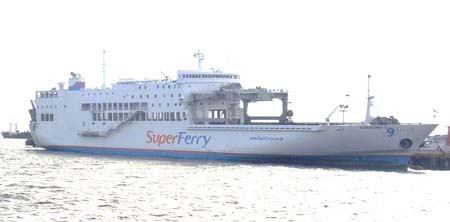 "Superferry 9" of Aboitiz, 2009 (Witherror, via Wikimedia)
"Superferry 9" of Aboitiz, 2009 (Witherror, via Wikimedia)
For the media the Philippines have become infamous for shipping catastrophes. In 1987 the "Dona Paz" of Sulpicio Lines collided with a tanker and at least 1,700 passengers lost their life. The "Cebu City" capsized in 1994 after a collision, killing 147 people. In 1996 the "Filipina Princess" of Sulpicio (acquired from the Daiichi Shipping Co.) stranded at Maricaban. In 2008 Sulpicio's "Princess of the Stars" (1984/23,824gt, ex "Ferry Lilac" of Shin Nihonkai) was put to sea despite a typhoon alert and sank with c.800 people. Sinking of "Superferry 9" of Aboitiz (ex "Ariake" of Daisan Kayu, "Mabuhay 5") finally caused inspection of other ferries and a temporary interruption of services. Another sort of catastrophe was the destruction of the "Superferry 14" in 2004. A bomb smuggled aboard caused fire, 116 persons were killed and the ship was lost. Four years later the supposed mastermind of the bombing was arrested at Bahrain.
Indonesian Ferries
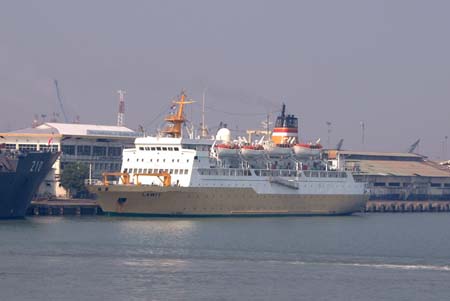 "Lawit" of Pelni at Tanjung Perak Port, Surabaya (Sakurai Midori, via Wikimedia)
"Lawit" of Pelni at Tanjung Perak Port, Surabaya (Sakurai Midori, via Wikimedia)
The innumerable Indonesian islands were connected with the multi-million metropolis Jakarta until 1957 by the mail steamers of the Dutch KPM. Then the government-owned Pelni or PT Pelayaran Nasional Indonesia employed second-hand vessels and small passenger-cargo ships, built in Poland, Germany and Yugoslavia. The ABC Shipping Guide listed in the late 70s also Pelayaran Nusantaara with Singapore services, car ferry routes of state railways PJKA, a once-monthly service to Timor by Nusa Tenggara and other routes.
A completely new series of ships, built by the Meyer Werft of Germany, was introduced by Pelni from 1983. First of the new motor-ships of c. 14,000 tons each, with 1st, 2nd, 3rd, 4th class cabins and sleeping-halls, but no car-decks, a buff hull, white superstructure and a yellow/white/red/black funnel was the "Kerinici". Unfortunately she ran aground a reef at North Sumatra in 1997. Smaller ships were built in Indonesia. Cook mentioned Pelni with departure at Jakarta Tanjung Priok for complicated one-week itineraries to Surabaya, Kalimantan (North Borneo), Sulawesi (Celebes), Bali and Jayapura in Irian Jaya (the formerly Dutch part of New Guinea, now Indonesia.).
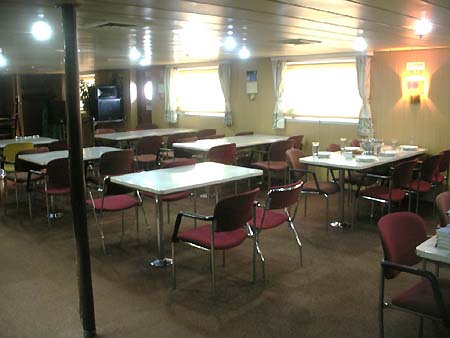
"Awu" of Pelni, restaurant, 2006 (Maximilian Doerrbecker, via Wikimedia)
|
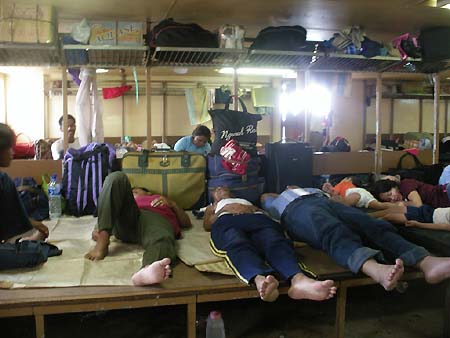
"Awu" of Pelni, economy classe (Maximilian Doerrbecker, via Wikimedia)
|
Initially a thrice-monthly service on the long route from Jakarta Tanjung Priok to Belawan on the north coast of Sumatra was maintained by PNSR. Now services to Belawan and to Padang on the Sumatra south coast are listed as a quasi-monopoly of Pelni, except a service Merak - Panjang by the railway enterprise PTKA. Cook's Overseas Timetable mentioned also some service connecting Pekanbaru on Sumatra with Melaka (Malacca) in Malaysia, what must mean a combined bus and shipping route.
Of course there are local car ferry services of various companies, mainly Perum, connecting Java with Sumatra and with Bali. The boats between Ketapang and Gilimanuk on Bali are conveying even buses of the long route Jakarta - Denpasar. Catamarans of Bali Hai Cruises, of Bounty Cruises and other boats served Bali tourism. Information via Internet is not sufficient for establishing a list.
Several shipping catastrophes had occurred in the South China Sea: In 1999 an Indonesian ferry, not licensed for passenger transport, sank and 312 people died. In 2001 the catastrophe of the Indonesian ferry "Cahay Bahari" off the coast of Sulawesi caused 500 casualties. In the same year a fishing-boat, crowded with refugees, sank off the coast of Sumatra and 400 people died. In 2007 the "Levina 1" caught fire and then she sank, taking down with her investigating policemen.
South Pacific Island Ferries
In the late 1970s, when regular ocean services ended, the ABC Shipping Guide listed a sporadic service from Melbourne to the Marshall Island of Majuro by the Nauru Pacific Line with the "Eigamoya", Carolineship sailings Palau - Jakarta - Kobe - Palau with the "Muskingum", the Tiger Line with the "Herkimer" connecting Japan with Micronesian islands, Fiji inter-island services by Rabi Enterprises with the "Neikuana" and "Al Sokula", the ports-of-call according to cargo requirements, and Silk & Boyd of Rarotonga, connecting the Cook Islands with Samoa and Fiji Islands, employing the "Manuvai" and "Mataora", the only passenger-cargo ships with car transport.
Local island services were provided by the Solomon Government, Coral Seas Ltd, Saratoga Shipping Co, Guadalcanal Council, Gilbert Islands Shipping Corp., Tuvalu Government, Fiji Government, Pacific Navigation Co and Tahiti - Moorea by Pierre Sachet.
After the age of car ferries had started, catamarans were introduced in Nouvelle Caledonie. The "Betico" of 1998 was replaced in 2008 by the "Betico 2", operated by Sudiles. Cook's timetable of 2009 mentioned Armement Loyaltien.
In Papua New Guinea the firm Lutheran Shipping maintained tradition and has a sort of monopoly on the North Coast. Also Laurabada undertook passenger/cargo shipping. Local services always were operated on the Mariana, Caroline, Solomon, Fiji, Tahiti and other islands. On Fiji Islands Beachcomber Roro Shipping and on Tahiti Aremiti Pacific Cruises introduced even hi-speed services. Moorea Ferry, started in 1991, maintained the connection between Papeete on Tahiti and the neighbouring island Moorea. Among the longer routes, Cook's Overseas Timetable of 2008/09 selected Tonga Island services Nuku'alofa - Neiafu and Vava'u by the Shipping Corporation of Polynesia, Samoa Island services Apia - Pago Pago by the Western Samoa Shipping Corp. and 15-day round-trips from Papeete to the Marquesa Islands and back with the Cie. Polynesienne de Transport Maritime. This company, founded by Mr Wong Wing for cargo shipping, offered from the 80s a passenger-cargo service, always with one ship, the latest the "Aranui 3". Little was known about all these services, impossible to be listed, until in 2009 the car ferry "Princess Ashika" capsized near Nuku'alofa, obviously hit by a freak wave.
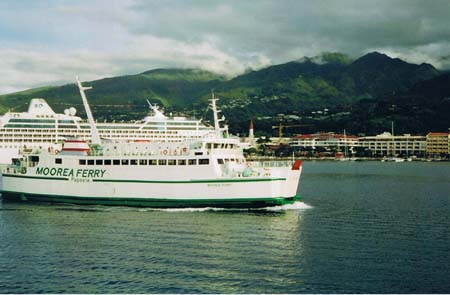 "Moorea Ferry" at Papeete, in the background a Princess Cruises R class, in 2002 (via Wikimedia)
"Moorea Ferry" at Papeete, in the background a Princess Cruises R class, in 2002 (via Wikimedia)
Gone have the days when the picturesque islands of the South Pacific were connected with the rest of the world by trans-oceanic or branch lines. What remained, are mainly freighters, tankers and - pirates. E.A. Ewart had delivered a lively report on piracy having threatened the South East Asian waterways a century ago: "In all the bays and inlets along the coasts their swift sail-and-oar prahus lurked, ready to pounce out on any sailing-vessel becalmed, or any steamer forced to stop to cool her engines or repair breakdowns. In such case out shot the prahus, crammed with men, urged to top speed by relays of rowers on the long sweeps. If they could surround their victim, they drove in from all sides, so that even a ship with guns could hardly stop the lot. Any prahus that got near enough showered 'stink-balls' down on the deck, choking the defenders with thick, blinding clouds of smoke and fumes... Finally, even after the trick of coupling up pipes to the boilers and meeting the attackers with scalding stream and water which kept them from boarding, the pirates developed a new plan of attack. A number of them took tickets as coolie deck passengers ....". In 1974 four terrorists of the Japanese "Red Army" and a Mideast militia seized a ferry boat at Singapore. They were stopped by the coast guard, but their combatants at Kuwait took the Japanese ambassador hostage and Japan generously had them flown out to Aden in communist South Yemen. Still a few decades ago a captain told the story of pirates who climbed aboard his freighter at Singapore.
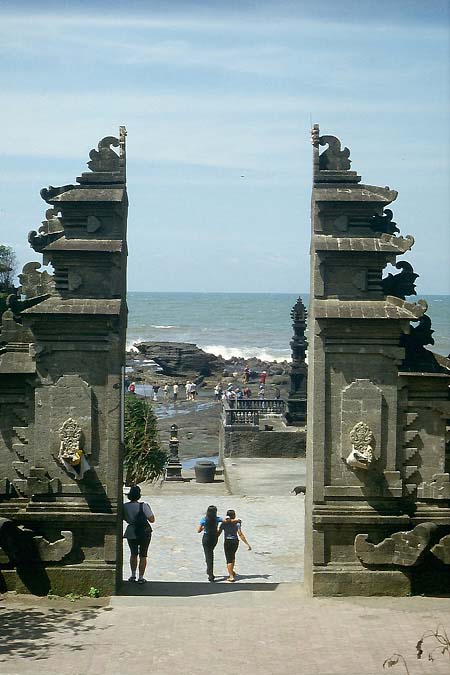 Bali, Tanah Lot (WS)
Bali, Tanah Lot (WS)
|